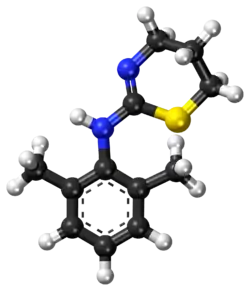زيلازين
زيلازين هو دواء بيطري مشابه للكلونيدين، وهو من الناهضات للصنف α2 من المستقبلات الأدرينالية.[1] يستخدم الزيلانين بشكل رئيسي في مجال الطب البيطري لغرض تهدئة وتخدير وإرخاء عضلات وتسكين الألم عند الحيوانات مثل الأحصنة والأبقار والثدييات الحيوانية الأخرى.[2] كما يمكن أن يستخدم الزيلازين مقيّئاً بيطرياً، خاصة للقطط.[3]
| زيلازين Xylazine | |
|---|---|
 | |
 زيلازين | |
| الاسم النظامي | |
| N-(2,6-Dimethylphenyl)-5,6-dihydro-4H-1,3-thiazin-2-amine | |
| اعتبارات علاجية | |
| اسم تجاري | Rompun, Anased, Sedazine, Chanazine |
| ASHPDrugs.com | أسماء الدواء الدولية |
| طرق إعطاء الدواء | إعطاء فموي أو استنشاق أو بالحقن (وريدي أو بالعضل أو تحت الجلد) |
| معرّفات | |
| CAS | 7361-61-7 |
| ك ع ت | QN05CM92 |
| بوب كيم | CID 5707 |
| IUPHAR | 523 |
| ECHA InfoCard ID | 100.028.093 |
| درغ بنك | 11477 |
| كيم سبايدر | 5505 |
| المكون الفريد | 2KFG9TP5V8 |
| كيوتو | D08683 |
| ChEMBL | CHEMBL297362 |
| بيانات كيميائية | |
| الصيغة الكيميائية | C12H16N2S |
| الكتلة الجزيئية | 220.33 غ/مول |
عادةً ما يستخدم الزيلازين في عمليات التخدير البيطري إلى جانب الكيتامين؛ ويباع تحت العديد من الأسماء التجارية، من بينها رومبون (Rompun) المسوق من شركة باير؛[2] وكذلك تحت اسم أناسيد (Anased)، وسيدازين (Sedazine).[4] يختلف تأثير الدواء بيطرياً حسب الحيوان المعالَج.[5][6][7]
يمكن لهذا العقار الدوائي أن يتعاطى من ضمن المخدرات، كما حدث في بورتوريكو؛[8] حيث استخدم بديلاً عن المخدرات المعروفة مثل الهيروين.[9]
طالع أيضاً
مراجع
- Greene, SA; Thurmon, JC (December 1988). "Xylazine--a review of its pharmacology and use in veterinary medicine". Journal of Veterinary Pharmacology and Therapeutics. 11 (4): 295–313. doi:10.1111/j.1365-2885.1988.tb00189.x. PMID 3062194. الوسيط
|CitationClass=تم تجاهله (مساعدة) - Xylazine at drugs.com نسخة محفوظة 8 مارس 2019 على موقع واي باك مشين.
- Patricia M. Dowling, Drugs to Control or Stimulate Vomiting (Monogastric), Merck Veterinary Manual. نسخة محفوظة 20 أبريل 2019 على موقع واي باك مشين.
- Ruiz-Colón, K; Chavez-Arias, C; Díaz-Alcalá, JE; Martínez, MA (July 2014). "Xylazine intoxication in humans and its importance as an emerging adulterant in abused drugs: A comprehensive review of the literature". Forensic Science International. 240: 1–8. doi:10.1016/j.forsciint.2014.03.015. PMID 24769343. الوسيط
|CitationClass=تم تجاهله (مساعدة) - Haskins, SC; Patz, JD; Farver, TB (March 1986). "Xylazine and xylazine-ketamine in dogs". American Journal of Veterinary Research. 47 (3): 636–41. PMID 3963565. الوسيط
|CitationClass=تم تجاهله (مساعدة) - Muir, WW; Skarda, RT; Milne, DW (February 1977). "Evaluation of xylazine and ketamine hydrochloride for anesthesia in horses". American Journal of Veterinary Research. 38 (2): 195–201. PMID 842917. الوسيط
|CitationClass=تم تجاهله (مساعدة) - Aithal, HP; Pratap, AK; Singh, GR (1997). "Clinical effects of epidurally administered ketamine and xylazine in goats". Small Ruminant Research. 24 (1): 55–64. doi:10.1016/s0921-4488(96)00919-4. الوسيط
|CitationClass=تم تجاهله (مساعدة) - Torruella, RA (11 April 2011). "Xylazine (veterinary sedative) use in Puerto Rico". Substance Abuse Treatment, Prevention, and Policy. 6: 7. doi:10.1186/1747-597x-6-7. PMC 3080818. PMID 21481268. الوسيط
|CitationClass=تم تجاهله (مساعدة) - Reyes, JC; Negrón, JL; Colón, HM; Padilla, AM; Millán, MY; Matos, TD; Robles, RR (June 2012). "The emerging of xylazine as a new drug of abuse and its health consequences among drug users in Puerto Rico". Journal of Urban Health. 89 (3): 519–26. doi:10.1007/s11524-011-9662-6. PMC 3368046. PMID 22391983. الوسيط
|CitationClass=تم تجاهله (مساعدة)
- بوابة طب
- بوابة صيدلة
- بوابة الكيمياء
- بوابة بيطرة
زيلازين في المشاريع الشقيقة
 صور وملفات صوتية من كومنز
صور وملفات صوتية من كومنز
This article is issued from Wikipedia. The text is licensed under Creative Commons - Attribution - Sharealike. Additional terms may apply for the media files.
